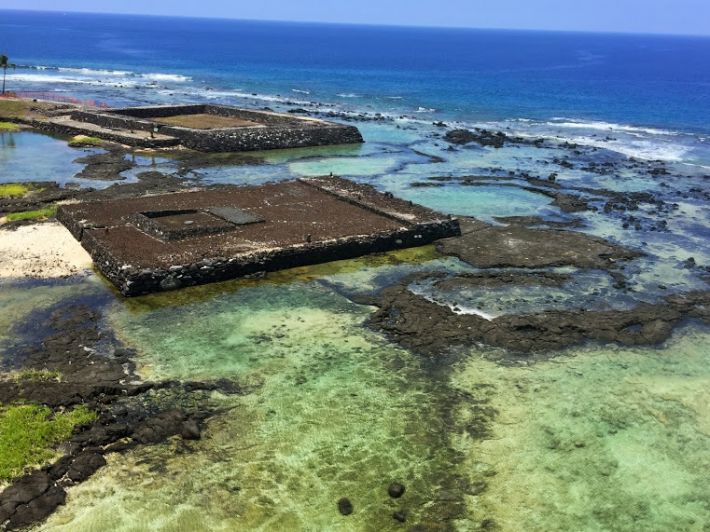Kamehameha Schools is improving education systems for Native Hawaiian learners by cultivating vital community partnerships in Hawai‘i and beyond. A recent collaboration with Arizona State University has made it possible for learners worldwide to explore some of Kona’s sacred cultural sites.
An educational partnership initiated in April between Kamehameha Schools and Arizona State University has developed a virtual huaka‘i (field trip) to enable learners to explore Hāpaialiʻi, Keʻekū and Kapuanoni heiau at Kahaluʻu Ma Kai in Kona, West Hawaiʻi.
Kahaluʻu Ma Kai is a culturally significant wahi pana (sacred place) that KS envisions as a hub for innovative Native Hawaiian ʻāina-based STEAM (science, technology, engineering, arts and math) education.
The virtual huaka‘i offers learners the same cognitive and affective gains as a real-life excursion and enables KS to share its cultural resources without disturbing the sacred sites, a concern for cultural practitioners.
This first phase of the project utilizes emerging online technologies to increase awareness and understanding of the Hawaiian cultural site through sharing of ʻike (knowledge) from West Hawaiʻi staff, who are experts on the cultural history and restoration of this sacred area.
The second phase includes working closely with Hawaiʻi Department of Education teachers and students in West Hawaiʻi and using the virtual huakaʻi to integrate Hawaiian Culture-Based Education and STEAM learning principles.
“Heiau are sacred sites that were the focal point of success for our aliʻi,” explains KS Cultural Resource Specialist Māhealani Pai. “We are redefining heiau for 21st-century learning as they were ancient universities housing various disciplines that connect us to ‘Ike Hawai’i” (Hawaiian knowledge).
The virtual huakaʻi offers a chance for self-exploration as multiple locations are portrayed using 360 spherical images, videos, interactive lessons and high-definition photos. Some topics covered in the tour include knowledge passed down from kūpuna, including heiau architecture, observing the sun to track seasons, tide pool ecosystems and a sense of kuleana (responsibility) to protect the ʻāina.
The cross-functional project team includes staff from the ASU School of Earth and Space Exploration and KS’ Community Engagement and Resources (CE&R) West Hawaiʻi, Kūamahi Kealakūlia and Digital Learning Innovations teams.
“It has been exciting to see a cross-functional KS team working with community partners like the Hawaiʻi State Department of Education and with national partners like ASU,” says Kaeo Duarte, KS’ vice president of CE&R. “It is a sign of our new strategic direction under Kūhanauna – working collectively with others for a greater impact. The innovative nature and speed with which the team completed the pilot is also an encouraging sign of the working culture we hope to nurture in our groups.”
Both organizations benefit from the project as ASU’s proprietary immersive virtual huakaʻi technologies and multimedia expertise merge with KS’ ʻĀina Pauahi (lands) and cultural expertise.
Key members of the team include: Geoffrey Bruce (ASU multimedia developer); Brandi Beaudet and Jamee Miller (project owners); Dorothy Hirata (project manager, digital innovations subject matter expert); Kēhau Puʻu (steering committee); Pai (cultural subject matter expert); Malani DeAguiar (ʻŌlelo Hawaiʻi subject matter expert); and Kahala Wery (curriculum subject matter expert).
“It’s been a wonderful experience collaborating with ASU and KS staff across the organization, and leveraging everyone’s expertise to produce a Hawaiian culture-based STEAM resource for our lāhui, kumu, haumāna and global audience to access,” Hirata says.
The project is currently entering the final public testing phase after Kahaluʻu Ma Kai descendants were initially consulted. The project team is currently moving forward with the next phase that involves coordinating and piloting the virtual huakaʻi with interested West Hawaiʻi schools. Future plans include expanding beyond West Hawaiʻi to include schools across the state. The project is tentatively scheduled for completion in December, 2017.
To explore the Kahaluʻu Ma Kai Virtual Huakaʻi, visit http://ksdl.ksbe.edu/kahaluumakai. Site visitors are also encouraged to complete the user experience survey. All comments and feedback data are analyzed to continually improve the experience.
STRATEGIC PLAN 2020
SP2020 is a five-year strategic plan that will guide Kamehameha Schools from 2015 to 2020. The plan marks a starting point toward KS’ Vision 2040, which envisions success for all Native Hawaiian learners.
This partnership aligns with Goal 2 of SP2020 as KS aims to improve education systems for Native Hawaiian learners. The project also aligns with Action 4 of Kamehameha’s Ten Actions for fiscal year 2016-2017 in which KS leverages community partnerships to improve educational systems for Native Hawaiians.
REVIEWS ARE IN
After exploring the virtual huakaʻi, early user testers including former KS distance learning participants called it “innovative,” “immersive,” and “informative.” Below are some of their responses:
“Well done! Hope you do many more sites. Especially sites (that are) difficult to get to. Really liked getting into and onto the heiau. Can do so without destroying/impacting the structures. Excellent for kupūna or anyone with limited mobility, or even for folks like me who cannot travel inter-island often, or when I do, don’t have time to go there.”
– Leimomi Kekina
“I really like and appreciate this opportunity to explore the heiau. I hope more are approached this way to be taught with the proper protocols, especially for visitors.”
– Marla Higginbotham
“Please continue your process of bringing Hawaiian education to the forefront. It is most needed for our future.”
– Kai Duriano

The virtual huaka‘i enables KS to share its cultural resources, including Hāpaialiʻi and Keʻekū heiau, without disturbing the sacred sites.

KS Cultural Resource Specialist Māhealani Pai and others serve as virtual tour guides.

Geoffrey Bruce, multimedia producer for Arizona State University’s School of Earth and Space Explorations, surveys and gathers three-dimensional images at the site to create the virtual huaka‘i.
TAGS
16-17action4,
commsuccess
CATEGORIES
Print with photos
Print text only










